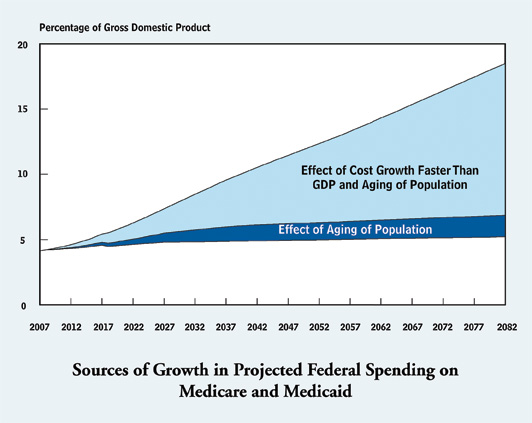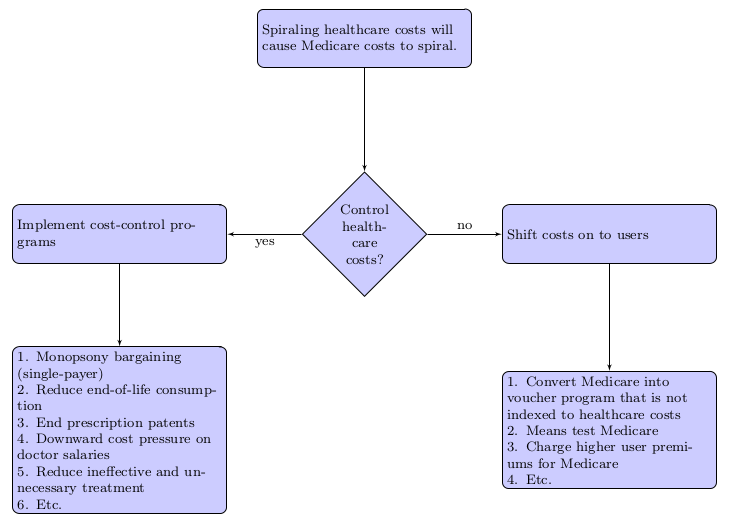Unlike Social Security, projected Medicare spending will dramatically outpace projected revenues in the next few decades. If nothing is done, Medicare will run huge deficits. Importantly, these projected deficits are not primarily driven by the shifting demographics of an aging population; rather, they are almost entirely driven by rapid growth in healthcare costs.

In 2007, the US spent 16 percent of its GDP on healthcare. Due to annual above-GDP growth in healthcare costs (private and public), this number is projected to steadily rise to 25 percent in 2025, 37 percent in 2050, and 49 percent in 2082. That is, if we make no changes to things before 2082 rolls around, half of the US economy will be dedicated to providing healthcare.
Because the cost of healthcare will rise, and Medicare pays for the cost of elderly healthcare, the cost of Medicare will rise too. In 2007, the US government spent 4 percent of GDP on Medicare and Medicaid, and that number is expected to steadily rise until it reaches 19 percent by 2082. It deserves emphasizing once again: this cost increase is a feature of healthcare costs rising, not demographic changes, not government bureaucracy, and not the inherent fiscal unsoundness of the Medicare model.
So the reality of Medicare’s fiscal situation is this: healthcare costs are spiraling and therefore Medicare costs are spiraling. There are basically two ways to prevent Medicare costs from spiraling: slow down the above-GDP growth in healthcare costs or dump these spiraling costs on to the elderly. I put together this flow chart to visualize the options:

If we choose to control healthcare costs, we can accomplish that by implementing a single-payer healthcare system or any number of other specific cost-saving mechanisms. If we do not choose to control healthcare costs, we also have a variety of options, all of which have the net effect of shifting those spiraling costs off of the government and on to the elderly. The first option listed in the cost-shifting part of the flow chart — a voucher program that is not indexed to healthcare costs — is the infamous Paul Ryan plan. Under that plan, the elderly would be on the hook for 68 percent of their healthcare by 2030 (right now, that number is 25 percent).
Anyone who is remotely sensible should prefer controlling healthcare costs over allowing them to spiral totally out of control. Shifting the spiraling costs of healthcare on to the elderly will reduce Medicare’s deficit, but seniors will suffer big time, and seniors lacking robust means will simply be unable to afford healthcare. More than that, allowing healthcare costs to spiral would hurt everyone, not just seniors. If healthcare costs spiral so much that they consume half of the economy, that will mean enormous healthcare costs for individuals and families. Imagine what your insurance costs now when healthcare consumes just 16 percent of the economy, and then imagine what they will be when healthcare consumes half of the economy.
So the two basic paths forward on Medicare are very clear. On the right side, we can do nothing to stop the meteoric rise in healthcare costs, shift those costs on to the elderly, and make healthcare more expensive for non-seniors at the same time. On the left side, we can tackle healthcare costs, avoid massive burdensome cost-shifting on to the elderly, and contain costs for the rest of the population as well. In my mind, the left option is the clear winner.